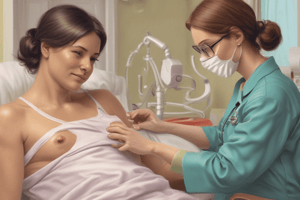Podcast
Questions and Answers
What is the primary way in which decreased sensory input contributes to a person's increased risk of pressure ulcers?
What is the primary way in which decreased sensory input contributes to a person's increased risk of pressure ulcers?
- Loss of cognitive function
- Loss of skin sensation (correct)
- Increased moisture levels
- Decreased mobility
What is the primary consequence of shearing force on the skin in relation to pressure ulcers?
What is the primary consequence of shearing force on the skin in relation to pressure ulcers?
- Sliding or dragging of the skin across a support surface (correct)
- Increased friction
- Decreased blood flow
- Increased moisture levels
What is the primary way in which friction input contributes to a person's increased risk of pressure ulcers?
What is the primary way in which friction input contributes to a person's increased risk of pressure ulcers?
- Increased moisture levels
- Decreased mobility
- Loss of skin sensation
- Abrasion of the epithelial surface of the skin (correct)
What is the primary consequence of moisture input on the skin in relation to pressure ulcers?
What is the primary consequence of moisture input on the skin in relation to pressure ulcers?
What is the primary association between nutritional status and pressure ulcers?
What is the primary association between nutritional status and pressure ulcers?
What is the primary consequence of anemia on pressure ulcers?
What is the primary consequence of anemia on pressure ulcers?
What is the primary consequence of cachexia on pressure ulcers?
What is the primary consequence of cachexia on pressure ulcers?
Which of the following is a risk factor for pressure ulcers?
Which of the following is a risk factor for pressure ulcers?
Flashcards are hidden until you start studying
Study Notes
Pressure Injuries
- Decreased sensory input due to skin degeneration in older adults can lead to a loss of sensation, increasing the risk of pressure ulcers.
- Cognitive problems, such as dementia, can impair moto function, making it difficult for individuals to move about and change positions, thereby increasing the risk of pressure ulcers.
Shearing Force
- Shearing force contributes to pressure ulcers by causing skin to slide or drag against a support surface, such as a mattress.
Friction
- Friction increases the risk of pressure ulcers by causing abrasion of the epithelial surface of the skin when it rubs against an abrasive or resistant surface.
Moisture
- Increased moisture on the skin or excessive dryness can exacerbate pressure injury development by increasing the risk of skin breakdown and altering skin integrity.
Nutritional Status
- Nutritional status is significantly associated with pressure injuries, and nutritional assessments can provide additional reference tools for predicting pressure injuries.
- Different nutritional statuses can modulate the risk of pressure injuries.
Anemia
- Anemia, a common blood disorder in elderly individuals, can hinder pressure ulcers healing by reducing the level of oxygen supplied to body tissues.
Cachexia
- Cachexia, a complication of cancer and its management, can lead to the development of chronic pressure ulcers when combined with prolonged immobility.
- Cachexia can result in infections and/or pressure injuries.
Studying That Suits You
Use AI to generate personalized quizzes and flashcards to suit your learning preferences.





